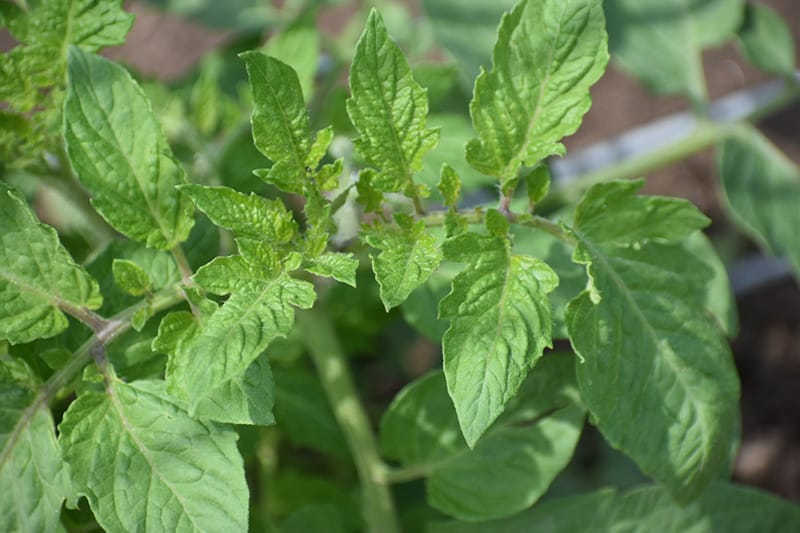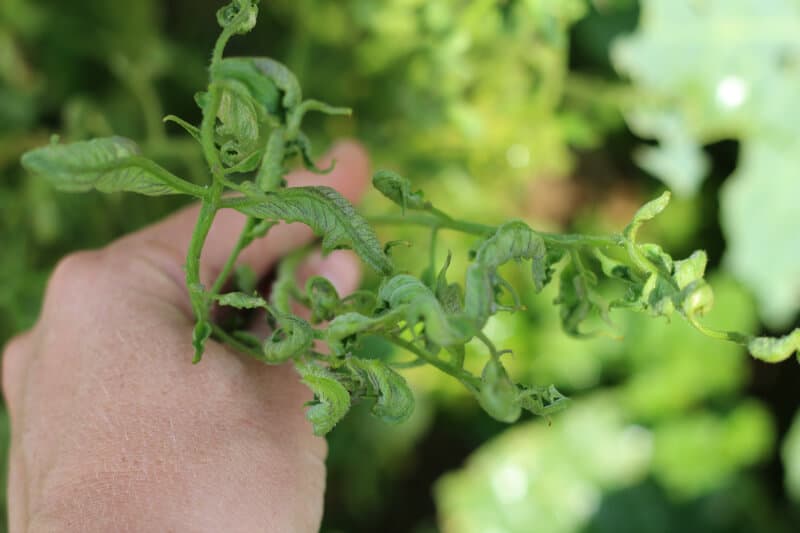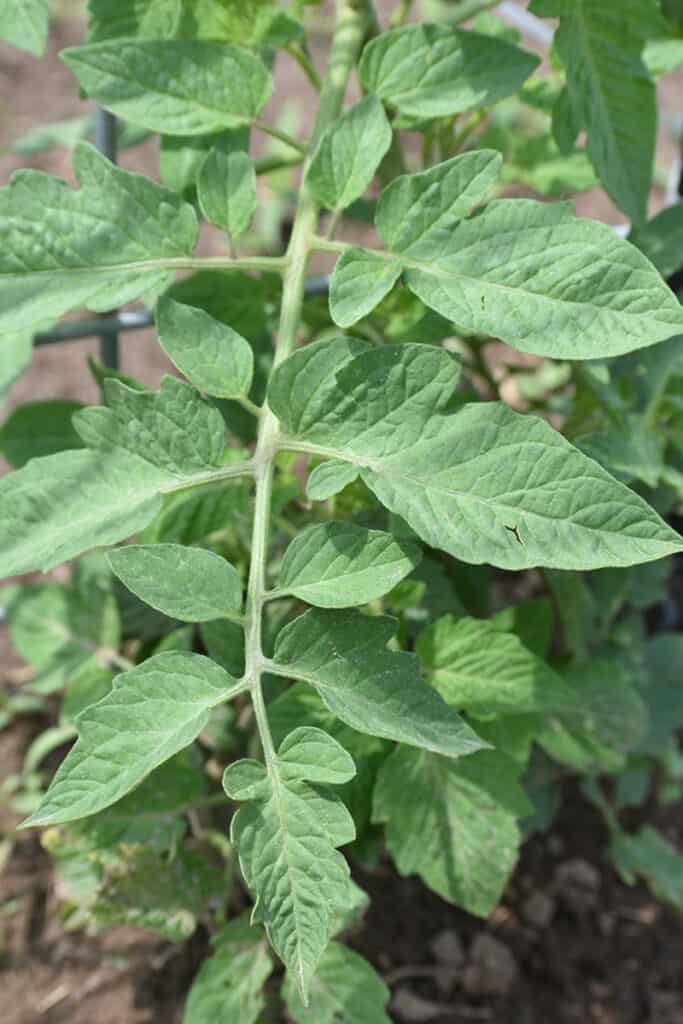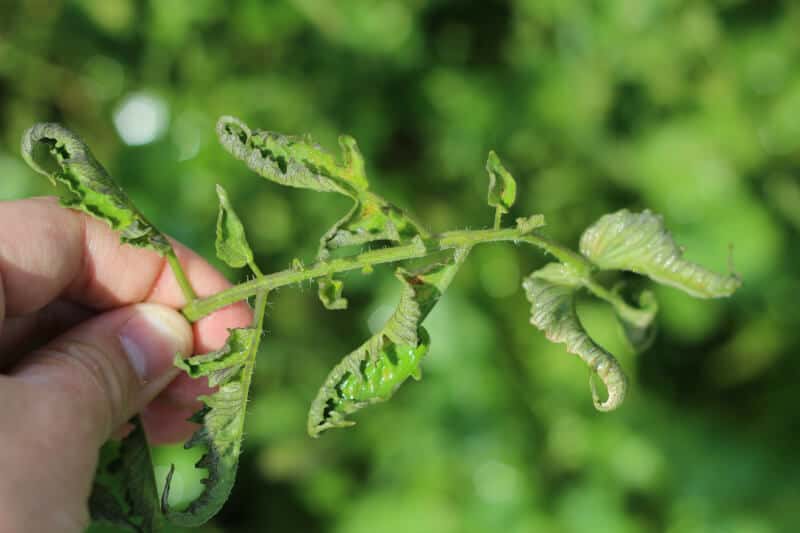There is nothing more amazing than harvesting those ruby-red romas or vibrantly colored heirloom tomatoes.
Many home-gardeners pride themselves on the success and health of their tomato plants. When something out of the ordinary happens, it can be heartbreaking. And finding that your precious tomatoes have tomato leaf curl can be one of those heartbreaking moments.
I have been one of those gardeners left wondering “Why are my tomato leaves curling?” (read my personal story with curled tomatoes leaves here). There are so many reasons for tomato leaf curl and I have learned that a little digging will be required to find your specific answer.
What Do Your Tomato Plants Look Like?

A healthy tomato plant (like the image above) is a nice shade of green, the shade can vary depending on your variety. The leaves should be open but may appear slightly droopy (the droop downward is normal especially with longer leaves). You should be able to see healthy new growth and flowers present.
When you notice that your plant doesn’t look healthy and the leaves are curling (see image below), it is time to start digging. Start by examining your plant and taking note of all abnormalities. You will want to look at the plant’s coloration, leaves, and stem to help weed out the many reasons your tomato leaves are curling.

Top Reasons Your Tomato Leaves Are Curling
1. Environmental Stress
Water Stress
- Not Enough Water
Hot and dry conditions during summer months can create drought conditions, these conditions can cause your tomato leaves to curl. Tomato plants will curl/roll their leaves to help conserve water as a type of self-preservation. - Too Much Water
Too much water is another form of water stress that can cause your tomato leaves to curl. The ground around your plant should be moist, not soggy, and definitely should not be standing water.
Too Much Nitrogen
If you think too much nitrogen is the reason for your leaves curling, a soil test will give you answers. When there is too much nitrogen in the soil the leaves on your plant will curl and be a darker shade of green.
You can use a home soil test for quick results, but if you want really accurate ideas about your soil, I highly recommend getting a soil test done by a lab. You can contact your local extension office to find the nearest soil testing facility. It’s amazing what info you can find out with an official soil test. Here’s my story on what I learned from getting a soil test done. Nowadays, I try to get a soil test done every other year.
Excessive Salt
Too much sodium in your soil can cause your tomato plant’s leaves to turn yellow and curl.
How do you get too much salt in your soil? If you purchase compost or manure from feedlots, there tends to be more salt content. You can also find this issue in colder climates that have salted roads in the winter, because it can cause runoff that will leave you with extra sodium. Gardens that are on the coastline near the ocean can also get excess salt from ocean spray.
If you believe that too much salt is in your soil is the cause of your tomato leaf curl, there are ways to manage soil salinity.
Overall, environmental tomato leaf curl is not a big deal and can be fixed if taken care of right away. If the stressor is left long-term, however, it will affect your harvest yield, plant growth and in some cases be fatal.
2. Broad Mites
A broad mite infestation is another common cause for tomato leaves to curl. Broad mites are tiny mites that you can’t see without magnification. An infestation can easily be confused with heat stress, water stress, or root damage.
Broad Mite Symptoms Include:
- Stunted Growth
- Leaf Curling
- Slight Yellowing
If your tomato plants are heavily infested, it may be best to remove them from your garden. Remember to destroy the plant. This will kill the mites and prevent further infestation. Minimally infested plants can possibly be saved, remove the damaged leaves and spray your plant with organic insecticidal soap.

3. Disease Can Cause Tomato Leaf Curl
Tomato plants are very sensitive and have many diseases that trouble them. Tomato Yellow Leaf Curl Virus, Tomato Mosaic Virus, and Cucumber Mosaic Virus are usually blamed when leaves start curling.
Tomato Yellow Leaf Curl Virus
Tomato Yellow Leaf Curl Virus is a disease that is spread by whiteflies on young infected transplants. It takes an infected plant up to 3 weeks to start showing signs of the disease. When symptoms do appear, you will see changes that affect the leaves, flower buds, and growth.
Tomato Yellow Leaf Curl Symptoms Include:
- Yellow Coloration of the Leaves
- Upward Curling Leaves
- Stunted Growth
- Lack of Flower Development
Unfortunately, Tomato Yellow Leaf Curl Virus has no cure, and the best thing to do is remove and destroy the infected plants.
To help prevent Tomato Yellow Leaf Curl Virus, you can try to keep weeds down (read more about natural weed control here) and also try to encourage beneficial natural predators to your garden by planting a diverse variety of plants in your garden that might draw different helpful insects (especially flowers and herbs).
Tomato Mosaic Virus and Cucumber Mosaic Virus
The Tomato Mosaic Virus and Cucumber Mosaic Virus are spread by infected seeds, plants, and equipment that have been exposed to the virus. There are symptoms to look for if one of the mosaic viruses is the cause of your tomato leaf curl.
Tomato Mosaic Virus and Cucumber Mosaic Virus Symptoms Include:
- Mottling of Leaves
- Mosaic Pattern of Yellow and Green on the Leaves
- Leaf Curling that Creates a Fern Like Appearance
Like the Yellow Leaf Curl Virus, there is no treatment for either type of these infected plants. You should pull all the diseased plants and burn them to prevent further spread of the virus. Cleaning your garden equipment regularly is a way you can help prevent the spread of the virus.
4. Tomato Leaf Curl Caused by Herbicide Poisoning
Over the years herbicide poisoning has become a larger problem for home gardeners. Aminopyralid and Clopyralid are the most common types of herbicides doing the poisoning. These are chemical weed killers that target broadleaf weeds, leaving grasses untouched.
Aminopyralid and Clopyralid are usually used in places like grass hay fields, not home gardens. Herbicide drift and herbicide residue are two ways these herbicides can find their way into your garden.
Herbicide Drift:
Herbicide drift is when the wind carries some of the sprayed herbicide to your plants.
Tomato plants fall under the category of extremely sensitive, so even a small amount of drift can affect your plant’s growth and fruit yield. Poisoning from herbicide drift can vary depending on the amount that has landed on your tomato plants.
Herbicide Residue:
Residue refers to the contamination of your soil that directly affects the root system of your plant.
Residue poisoning found in your tomato plants can come from contaminated manure, mulch, compost, or direct application.
- Aminopyralid and clopyralid can live through the digestive system of animals; if they have consumed feed sprayed with these herbicides their manure becomes contaminated.
- Compost can become contaminated by grasses, hay, and animal manure that have these herbicides on them.
- Hay or grass mulches that are sprayed with these herbicides will also contaminate your garden, allowing herbicides to leech into your soil.
Herbicide Residue and Herbicide Drift Symptoms Include:
- Downward Curling of the Leaves
- Stunted & Twisted New Growth
- Coloring Can Remain Untouched
- Affects Other Broadleaf Plants in Your Garden
Here are some helpful images of herbicide poisoning symptoms.
You can also check out my recent video where I learned for the SECOND time that I had tomato leaf curling due to herbicides in my compost:
Removing Residue Contamination
Unfortunately, this kind of herbicide contamination can last for years in your soil, mulch, or compost. If one of these has been contaminated, there are only a few options.
Contaminated Mulch unfortunately has already done damage to your garden soil, but it can be removed and destroyed.
Contaminated Compost should stop being used. Then, it can be left alone and watered down. The water will help dilute the herbicides. In my video (above), I also talk about how spreading the compost out in a thin layer can help speed up the process of aging-out the herbicides from your compost. I would recommend testing your compost before any future use.
Contaminated Soil is by far the hardest to deal with, and the things you can do include:
- Removal of soil (depending on your type of garden)
- Move your garden to another area
- Plant a grass cover crop in the affected area (learn more about cover crops here)
- Water the area down to dilute the Herbicide
- Wait it out, which could take many years
Herbicide Poisoning Plant Fatality
There is no reversal to herbicide poisoning, and the fatality depends on the degree of contamination.
Herbicide drift damage will depend on the amount of exposure. The damaged leaves can be removed, and new growth may not be affected. If entire tomato plants have been affected, remove and destroy them.
Herbicide residue damage is always fatal, and the tomato plants should be removed and burned to prevent future contamination.
Herbicide Poisoning Prevention
As home-gardeners, all we can do is do our best to avoid the nightmare of herbicide poisoning. There are things you can try to prevent these herbicides from entering your garden:
Herbicide Drift Prevention
- Politely ask neighboring farms if they use these herbicides and if you could be notified before spraying. This will give you time to cover as much as you can ahead of time.
- If herbicides are being sprayed, you can try to place your garden in an area less likely to get drift spray.
Herbicide Residue Prevention
- Create your own compost with only known sources.
- Choose your source CAREFULLY when purchasing hay for deep mulch gardening or feeding your livestock.
- Ask hay sellers if Aminopyralid or Clopyralid have been used in the last 18 months.
- Do not use manure in compost from animals that have eaten feed that has been sprayed with these herbicides within the last 3 days.
Herbicide poisoning can turn your gardening dream into a nightmare, especially when you believe everything has been done right. Many are unaware of what is happening until something like tomato leaf curl shows up.
Why Are Your Tomato Leaves Curling?
Tomato leaf curl can be a scary thing for a home gardener who is looking forward to their beautiful harvest. Try not to jump to conclusions or think the worst. Do some digging and find out if your tomato leaf curl journey ends with something as simple as an environmental stressor. At the very least, consider getting a lab-run soil test done on your garden ASAP when you spot the first signs of tomato leaf curl so you can get the best idea about what is happening.
I also want to gently remind you that mistakes can happen and you should try not to feel overwhelmingly guilty if something is wrong with your tomato leaves. I have had TWO bad cases now with tomato leaf curl and they were both based on herbicides and left me with a less-than-desirable garden situation (learn about my deep mulch poisoning here and my compost poisoning here).
Both times were tough, but the blessing-in-disguise was that I took those opportunities to learn a ton of info about my plants and my garden and where I need to purchase mulch and compost in the future.
More Gardening Tips:
- The Best Organic Fertilizers for Your Garden
- DIY Organic Aphid Spray for Your Garden
- Making and Using Compost for Your Garden
- How to Plant Cover Crops

The post Top Reasons For Tomato Leaf Curling appeared first on The Prairie Homestead.
Via Gardening http://www.rssmix.com/
No comments:
Post a Comment